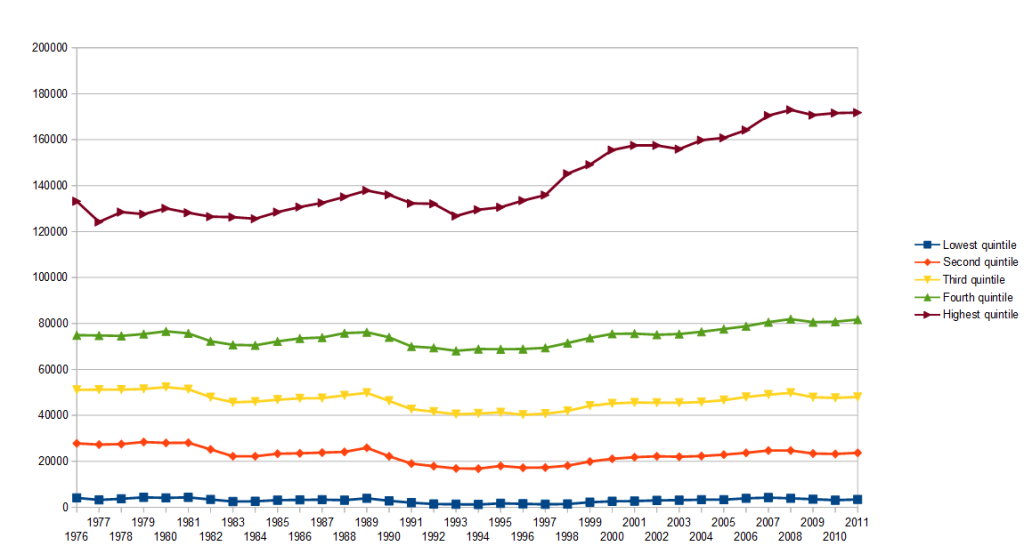How Is Canada’s Middle Class Really Doing?
There’s been an awful lot of talk lately about the middle class in Canada. The federal Liberals and NDP are both building up toward next year’s election by claiming that they are the party which will help resolve the plight of Canada’s middle class. The Conservatives, meanwhile, are quite happy to tout their record in office by citing this recent New York Times article saying that Canada’s middle class is among the best off in the world. Many pundits in the Canadian press, whether they write for the Globe and Mail, National Post, or Macleans, tend to side with the Conservatives. So what’s really going on here?
I’ve put together a chart using Statistics Canada data (specifically CANSIM Table 202-0701) showing income trends among Canadian families divided by income quintile over the entire period for which Stats Can has relevant data, which turns out to be the 35 years from 1976 to 2011. (click on the image for a larger and more readable version)
People like the National Post’s Andrew Coyne will tend to describe income trends by starting in the late 1990s. And it’s certainly true that since the late 1990s, incomes have been rising for every income group, including low and mid income earners. But I think starting at that point is very misleading. Those incomes rises, at least for the bottom 3 quintiles here, were just wiping out losses sustained in the late 80s and early 90s. That’s actually a pretty awful record.
To simplify things, let’s look just at the middle income quintile, the one that is most obviously “middle class”. Middle class families had an average income of $49,800 in 1989 just before the economy crashed. They fell to a low of $40,500 in 1993. They didn’t get back to the $49,800 level until 2008 (and have since fallen a bit). It took 15 years to wipe out the losses sustained between 1990 and 1993. I don’t look at that and say “Oh, the middle class has been doing well lately,” I look at it and say “Wow, it took 15 years for the middle class to get back to the level it was at in the late 1980s, and even now it still isn’t any further ahead than it was then.” And the picture looks even worse if you go further back: this middle quintile’s average income peaked in 1980 at $52,300, a level it still hadn’t returned to as of 2011 (the most recent year for which I could find data), 31 years later!
Here’s one way to think about that: if you’re in your 30s and middle class right now, your generation is no further ahead than your parents’ was. And this is despite big GDP growth over the same time period. In 1989, when incomes for the middle quintile peaked, GDP was $994 billion; in 2011 it was $1.634 trillion. GDP grew by nearly two-thirds over those years, but the average middle class Canadian income saw no growth! The richest quintile of Canadians, on the other hand, took a much shorter amount of time to regain the losses they suffered in the early 90s – they were up above 1989 levels by 1998. And since then their incomes have continued to go up and up and up. (GDP data in this paragraph is from CANSIM Table 384-0038. You can look up a CANSIM table and mess around with the data here.) [Note: An earlier version of this paragraph used nominal rather than inflation-adjusted GDP values, and thus over-stated GDP growth. That error has been corrected.]
So yes, despite the fact that middle class incomes have been rising for about 15 years, there’s still very good reason to be angry. The economy continued booming, but the gains from that economic growth were overwhelmingly concentrated in the top income earners. While not everybody will know the specific statistics I’ve cited here, this general story – of stagnating incomes for all but the top earners – is widely known. The economy has grown by leaps and bounds and most Canadians have not seen much benefit from it in terms of their income. That’s a big problem.


